Select Language

Chinese technology stocks, including those that supply to Apple (NASDAQ:AAPL), rose sharply on Monday after President Donald Trump’s administration signaled that electronics were exempt from his steep reciprocal trade tariffs on Beijing.
While Trump did say that this was only temporary, and that he will separately tariff electronics imports, markets took some relief from the temporary exemption. Tech in particular was battered by an escalating U.S.-China trade war in recent weeks.
In China, Apple suppliers such as Luxshare Precision Industry Co Ltd (SZ:002475) and AAC Technologies (OTC:AACAY) Holdings Inc (HK:2018) rose between 1% and 3%, while electronic devices giant Lenovo Group (HK:0992) soared over 5%. The Hang Seng index also rallied nearly 3%.
Other Chinese tech stocks- such as chipmaker Semiconductor Manufacturing International Corp (HK:0981), and internet giants Alibaba (HK:9988), Baidu (HK:9888), and Tencent Holdings Ltd (HK:0700)- also rose sharply, recouping a measure of recent losses.
China’s electronics manufacturers are heavily exposed to U.S. exports, with China also playing a key role in the manufacturing supply chain of majors such as Apple.
Trump’s rapidly escalating trade war threatens to destabilize this trend, given that roughly 90% of Apple’s flagship iPhone is manufactured in China.
The increased tariffs could result in a broad-based hike in U.S. electronics prices, at a consumer and industrial scale.
Apple’s Asian suppliers outside China also mostly advanced. In Taiwan, Hon Hai Precision Industry Co Ltd (TW:2317), also known as Foxconn, jumped over 4%.
South Korea’s Samsung Electronics (KS:005930) added 1.5%, while in Japan, suppliers such as Sharp (OTC:SHCAY) Corp (TYO:6753) and Sony Corp (TYO:6758) rose 3.5% and 1.7%, respectively.
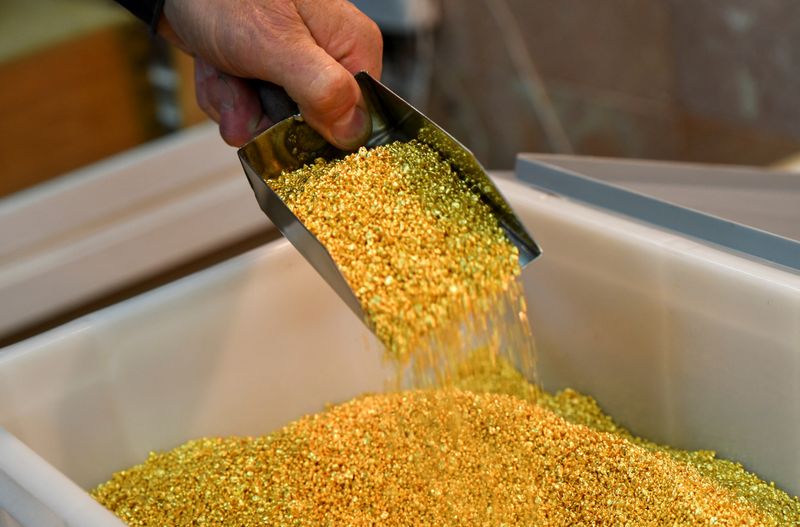
Gold prices fell from a record high on Monday as risk appetite improved marginally on the U.S. flagging some exemptions from steep trade tariffs against China, although sentiment still remained largely on edge.
Weakness in the dollar and Treasury prices also kept gold relatively underpinned and trading above $3,200 an ounce, as did some comments on monetary easing from the Federal Reserve.
Spot gold fell 0.3% to $3,225.79/oz, while gold futures expiring in June fell 0.1% to $3,240.87/oz by 01:12 ET (05:12 GMT). Spot gold remained close to a record high of $3,245.69/oz hit last week.
Gold pressured by brief tariff relief as risk appetite recovers
Losses in gold came amid gains in risk-driven markets, with Asian stocks mostly rallying on Monday. U.S. stock index futures also rose in Asian trade.
Risk appetite improved after the White House over the weekend confirmed that electronic goods will not be included in President Donald Trump’s staggering 145% tariffs against China. The move offers some relief to major U.S. firms with heavy import exposure to China, especially Apple Inc (NASDAQ:AAPL).
But Trump downplayed this notion, stating that electronic imports will still face a 20% levy, and that he was preparing to announce separate import tariffs on electronics soon.
Trump’s comments kept investors on edge over more tariffs, especially as China and the U.S. engaged in a bitter tariff exchange last week.
Beijing announced 125% retaliatory tariffs against the U.S. over Trump’s latest move, and showed little intent to back down. China was also seen reaching out to other trading partners to improve bilateral trade.
Still, a dire trade war between the world’s biggest economies is expected to rattle global supply chains and economic growth, with traders seen pricing in at least a 50% chance of a U.S. recession this year.
This notion had boosted gold prices in recent weeks, while most other metals lagged. Still, weakness in the dollar offered some relief to metal markets on Monday.
Platinum futures rose 0.8% to $951.90/oz, while silver futures fell 0.3% to $31.827/oz.
Among industrial metals, copper futures on the London Metal Exchange steadied at $9,152.90 a ton.
Goldman Sachs hikes 2025 gold price target to $3,700/oz
Goldman Sachs Group Inc (NYSE:GS) on Sunday hiked its 2025 gold price target to $3,700/oz from $3,300/oz- its third such increase this year.
The investment bank flagged heightened safe haven demand for bullion in the face of a bitter U.S.-China trade war, and said that in an extreme scenario, gold could surge as high as $4,500/oz by end-2025.
Goldman Sachs also said that gold was a hedge against increased risks of a U.S. recession.
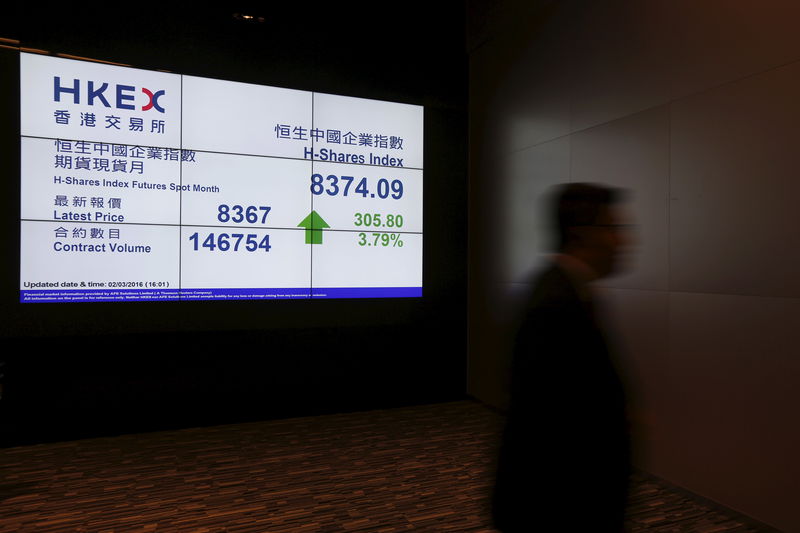
Asian stocks rose sharply on Monday, with Hong Kong’s Hang Seng index up the most on gains in technology after U.S. authorities signaled that electronics would be temporarily exempt from steep trade tariffs on China.
Gains in Asian markets also came following a positive Friday session on Wall Street, following assurances of economic support from the Federal Reserve, as well as a swathe of strong bank earnings.
U.S. stock index futures rose in Asian trade on Monday, with S&P 500 Futures up about 1%. Tech majors such as Apple Inc (NASDAQ:AAPL), which depend heavily on China for manufacturing, are expected to clock strong gains on the limited tariff relief.
Hang Seng rallies over 2% as Asia tech cheers some US tariff exemptions
Hong Kong’s Hang Seng index was by far the best performer on Monday, rallying 2.7%. Other tech-heavy bourses in the region also advanced, with South Korea’s KOSPI adding 1%, while Japan’s Nikkei 225 index rose 1.5%.
Hong Kong-listed tech stocks, particularly those with U.S. export exposure, logged strong gains after the White House signaled on Friday that electronics will be exempt from President Donald Trump’s steep 145% tariffs on China. PC maker Lenovo Group (HK:0992) was the top gainer on the Hang Seng, with a 5.4% gain. Other tech majors including Alibaba (HK:9988), Baidu (HK:9888), and Haier Smart Home Co Ltd (HK:6690) rose between 4% and 5.5%.
But Trump said over the weekend that this was temporary, and that he was planning to announce separate tariffs on electronics, which could include semiconductors. Trump also pledged a national security trade investigation into the chipmaking sector, while noting that electronics imports from China were still subject to a 20% tariff imposed in March.
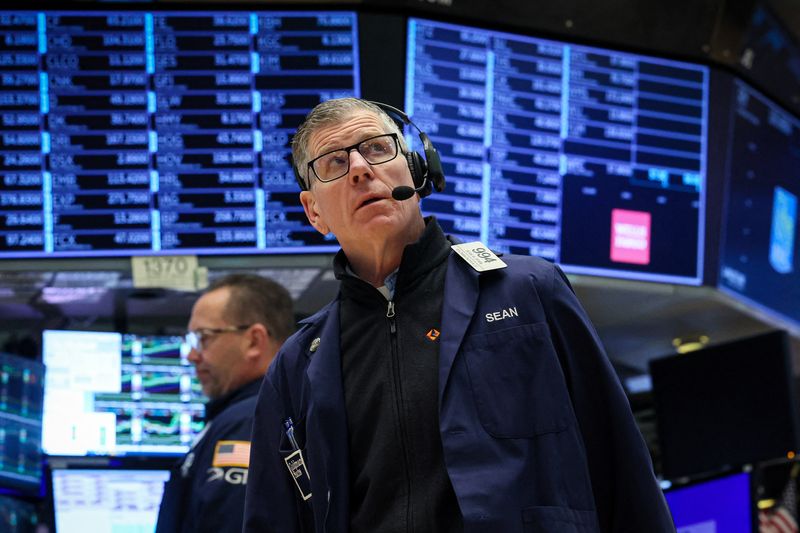
U.S. stock index futures rose on Sunday evening as investors cheered the exclusion of electronics from President Donald Trump’s steep reciprocal trade tariffs on China, although Trump still warned of more tariffs on the sector.
Futures rose after a positive session on Wall Street on Friday, as assurances from the Federal Reserve and a swathe of positive first-quarter bank earnings helped ease jitters over a rapidly escalating U.S.-China trade war.
Focus this week is on more key earnings, while comments from Fed Chair Jerome Powell are also on tap. Investors are also expected to closely monitor any more cues on Trump’s tariffs, with the President stating that he will provide more details on his tariff plans on Monday.
S&P 500 Futures rose 0.9% to 5,438.0 points, while Nasdaq 100 Futures rose 1.2% to 19,034.75 points by 19:26 ET (23:36 GMT). Dow Jones Futures rose 0.6% to 40,635.0 points.
Trump says electronics to still be tariffed, more duties coming
Trump on Sunday railed against reports that electronics will be excluded from his sweeping “reciprocal” tariffs against China, which the President had hiked to a cumulative 145% last week.
Trump said that imports of electronics such as smartphones and laptops will still be subject to 20% tariffs related to fentanyl, while his administration signaled that electronics, including semiconductors, will be subject to separate tariffs in the coming months.
Still, the exclusion of electronics from Trump’s 145% tariffs on China grants some reprieve to tech majors with heavy exposure to China, specifically Apple (NASDAQ:AAPL) and Tesla (NASDAQ:TSLA).
The White House said the exclusions were aimed at giving companies more time to shift production to the United States.
Wall St ends higher after whipsaw week
While news of the tariff exemptions came towards the end of Wall Street’s Friday session, U.S. stocks still clocked strong gains after wild swings last week.
Market volatility was amped up by Beijing and Washington rapidly escalating trade tariffs against each other. China imposed a 125% duty on all American imports, and showed little signs of backing down.
Still, assurances of economic support from the Fed, coupled with strong bank earnings, helped Wall Street close positive for the week. JPMorgan Chase & Co (NYSE:JPM), Morgan Stanley (NYSE:MS),and Wells Fargo & Company (NYSE:WFC) all clocked stronger-than-expected Q1 earnings.
The S&P 500 jumped 1.8% to 5,363.36 points, while the NASDAQ Composite rose 2.1% ot 16,724.46 points on Friday. The Dow Jones Industrial Average rose 1.6% to 40,212.71 points.
More Q1 earnings are due in the coming days, with Goldman Sachs Group Inc (NYSE:GS) set to report on Monday, while Johnson & Johnson (NYSE:JNJ), Bank of America Corp (NYSE:BAC), Citigroup Inc (NYSE:C), and United Airlines Holdings Inc (NASDAQ:UAL) set to report on Tuesday.
Several Fed officials are also set to speak this week, most notably Chair Powell on Wednesday.

By Leika Kihara and Makiko Yamazaki
TOKYO (Reuters) -Japan is gearing up for trade negotiations with the United States that will likely touch on the thorny topic of currency policy, with some officials privately bracing for Washington to call on Tokyo to prop up the yen.
Prime Minister Shigeru Ishiba on Friday set up a task force to oversee trade negotiations with the United States, headed by his close aide and Economy Minister Ryosei Akazawa, who domestic media said will visit Washington next week.
U.S. President Donald Trump’s focus on addressing a huge trade deficit, and his past remarks criticising Japan for intentionally maintaining a weak yen, mean markets are expecting Tokyo to come under pressure to strengthen the yen versus the dollar and give U.S. manufacturers a competitive advantage.
The slow pace at which the Bank of Japan is raising borrowing costs from ultra-low levels could also come under fire in bilateral trade talks, three sources familiar with the negotiations said.
"It’s clear the U.S. side is interested in talking about the yen and monetary policy," said one of the sources, who spoke on condition of anonymity. Another source said Washington wants a reversal of the weak yen, but has not offered Tokyo clarity on its preferred steps.
Public broadcaster NHK reported on Friday that Akazawa will on April 17 meet U.S. Trade Representative Jamieson Greer and U.S. Treasury Secretary Scott Bessent, a former billionaire hedge fund manager known for his strong interest in the yen and BOJ policy.
"I understand Mr. Bessent is very fond of Japan and undoubtedly has a good impression of our country. He also has a deep financial background, so could be a tough counterpart to negotiate," Akazawa told a news conference.
"He seems to mention non-tariff barriers and currency policy as among topics he’d like to discuss. If so, we will obviously respond during the discussions," he said, adding that Japan will not take any topic off the table.
Trump expressed a strong interest in Japan’s currency policy in phone call with Ishiba on April 7, Kyodo news agency reported on Friday, citing a Japanese government source.
Finance Minister Katsunobu Kato is likely to travel to Washington later this month for a meeting with his G20 counterparts on the sidelines of the spring IMF gathering, that could also offer the opportunity for a first face-to-face meeting with Bessent.
The BOJ is expected to hold interest rates at 0.5% at its two-day policy meeting concluding on May 1 while it scrutinises the impact of Trump’s tariffs, but some analysts say it may feel the need to signal that further rate hikes are on the way to avoid causing further declines in the yen.
EXTRA BUDGET EYED
In a stunning reversal, Trump said on Wednesday he would temporarily lower the hefty duties newly imposed on dozens of countries while further ramping up pressure on China.
The "reciprocal" tariff imposed on Japan has been cut to the universal 10% rate, from 24%, during the 90-day pause. A 25% duty still applies for automobile imports.
Akazawa and Chief Cabinet Secretary Yoshimasa Hayashi will lead the 37-member task force consisting of staff from various ministries to seek concessions from the United States.
A former transport ministry bureaucrat, Akazawa is among Ishiba’s closest aides and has deep ties with the domestic agriculture sector. His current role as economy minister is his first ministerial post.
While government officials have revealed little about Tokyo’s negotiating strategy with Washington, lawmakers have begun pressuring the government to take steps to cushion the potential economic blow from the tariffs.
The ruling coalition of Ishiba’s Liberal Democratic Party (LDP) and its partner Komeito is considering requesting a temporary cut to Japan’s sales tax rate for food, the Yomiuri newspaper reported on Friday.
Ishiba may also instruct his cabinet as early as next week to compile a supplementary budget to fund cash payouts and fuel subsidies, Kyodo news agency reported.
The calls for expansionary fiscal policy come ahead of an upper house election expected in mid-July, in which the LDP is likely to struggle given Ishiba’s low approval ratings.
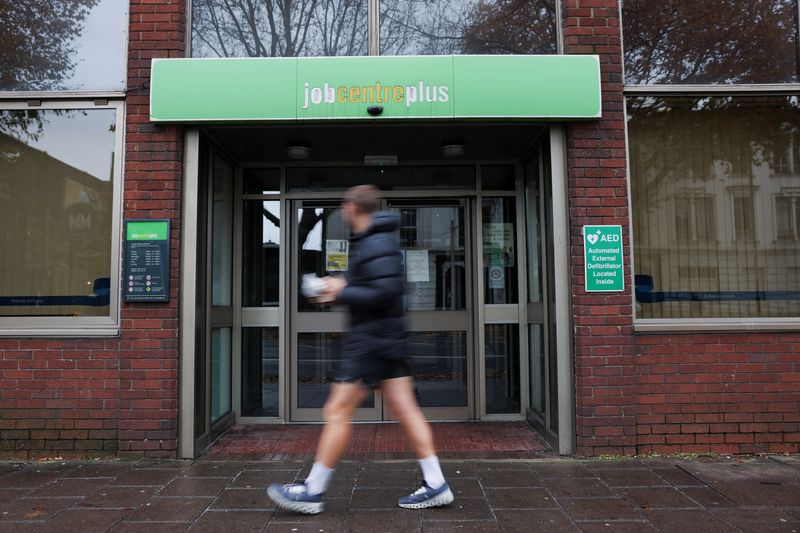
LONDON (Reuters) - Britain’s jobs market weakened again in March with the number of people looking for work rising by the most in more than four years as companies laid off staff and were cautious about hiring, according to a survey published on Friday.
The Recruitment and Employment Confederation said the pace of hiring slowed, extending a run of falls in permanent placements to two and a half years although the decline was less sharp than at the start of the year.
The availability of staff grew at the fastest rate since December 2020 with redundancies and fewer job openings cited as factors behind the increase.
However, REC chief executive Neil Carberry saw signs that the drop in hiring was easing, even as employers faced up to higher social security contributions ordered by British finance minister Rachel Reeves which came into effect this month.
"Given the substantial effects of the government’s decision to increase payroll taxes hugely, these figures were if anything slightly better than expected and suggest that there is potential in the market," Carberry said.
"A cyclical hiring upturn was always likely in 2025, but the near-term prospects for this have been made all the more uncertain by the actions of the US government in upending the global trade system," he said.
The REC survey, carried out with accountancy firm KPMG, was conducted between March 12 and March 25, before U.S. President Donald Trump’s announcement of sweeping import tariffs, most of which he scaled back on April 9.
REC said its measure of pay growth for permanent hires remained subdued by historical standards despite a pick-up in March from February’s four-year low. Temp wage growth improved slightly to a three-month high.
The Bank of England is monitoring inflation pressures in the jobs market as it considers when next to cut interest rates.
A separate survey published on Friday showed consumer confidence remained flat in the first quarter of 2025.
Accountancy firm Deloitte said its gauge of consumer confidence rose by a marginal 0.3 percentage point.
"Amid high levels of global uncertainty, a more cautious UK consumer is likely to constrain the ability of businesses to pass on higher wage and other costs to customers," Ian Stewart, chief economist at Deloitte, said.
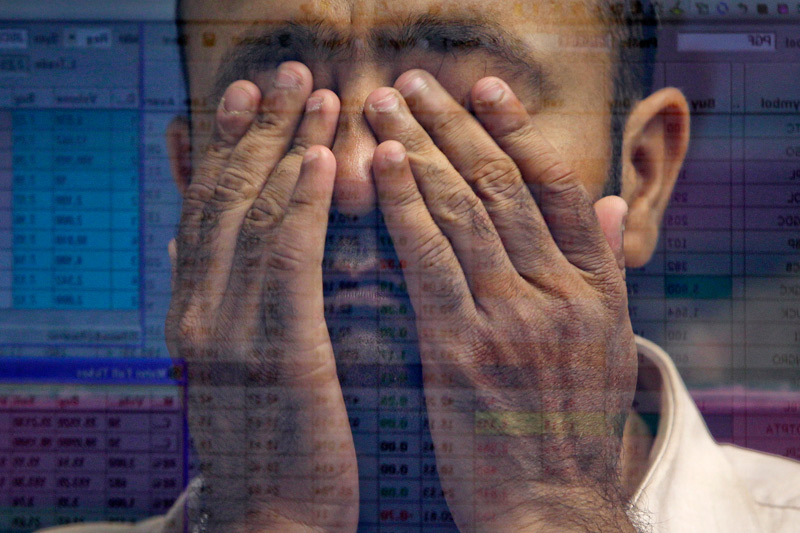
Asian stocks slid on Friday with Japanese markets leading losses on heightened concerns over the fallout of a worsening U.S.-China trade war, which largely offset relief over the U.S. postponing some trade tariffs.
Regional markets tumbled tracking an overnight slump on Wall Street, as a rebound rally, on President Donald Trump’s 90-day exemption on reciprocal tariffs, was largely wiped out by signs of worsening Sino-U.S. trade tensions.
Trump imposed even higher tariffs against China, drawing ire and threats of more retaliation from Beijing. Both Washington and Beijing showed little intent to immediately begin trade talks.
Wall Street futures wiped out early gains and fell in Asian trade, with S&P 500 Futures down 0.8%.
In Asia, Japanese stocks were by far the worst performers, given that the country holds large export exposure to both the U.S. and China.
Mainland Chinese stocks fell relatively less than their peers, boosted by apparent buying by state-backed funds- China’s so-called national team.
Nikkei leads losses as trade-heavy sectors slump
Japan’s Nikkei 225 index slid as much as 5%, as did the broader TOPIX index.
Losses were aimed chiefly at sectors with big exposure to international trade, such as automobiles and technology, which face slowing demand in both the U.S. and China.
Japan took some relief from Trump postponing 24% tariffs against the country. But Citi analysts noted that Trump’s 10% universal tariffs, plus an additional 25% levy on automobiles, still presented near-term headwinds.
Citi slashed its 2025 gross domestic product outlook for Japan, and pushed forward expectations for the Bank of Japan’s next interest rate hike to March 2026 from June 2025.
Still, Citi said that Japan will avoid a recession this year on strength in personal consumption, following another round of bumper spring wage hikes.
China stocks fall less than peers despite trade war escalation
China’s Shanghai Shenzhen CSI 300 and Shanghai Composite indexes fell 0.6% and 0.2%, respectively, while Hong Kong’s Hang Seng index lost 0.5%.
Chinese state-owned funds were seen snapping up more local equities this week, helping brace markets against worsening trade relations with the U.S.
Beijing vowed more support for local markets, while also outlining plans to release more stimulus. Local media reports showed officials considering expediting planned stimulus measures in the face of a U.S. trade war.
This notion drove some buying into domestically exposed Chinese stocks, especially in sectors such as industrials and consumer goods.
But weaker-than-expected Chinese inflation data released earlier this week indicated that Beijing had much more work to do to support the economy. Trump’s tariffs 145% tariffs- which took effect on Thursday- are expected to further complicate the government’s efforts.
China’s 84% retaliatory tariffs against the U.S. took effect from Thursday, with Beijing showing little intent to deescalate.
Broader Asian stocks were all negative, reversing course after a short-lived rebound in the prior session. Singapore’s Straits Times index shed 2.1%, while Australia’s ASX 200 fell 1.3%.
South Korea’s KOSPI lost 1.3%, while futures for India’s Nifty 50 index pointed to a weak open.
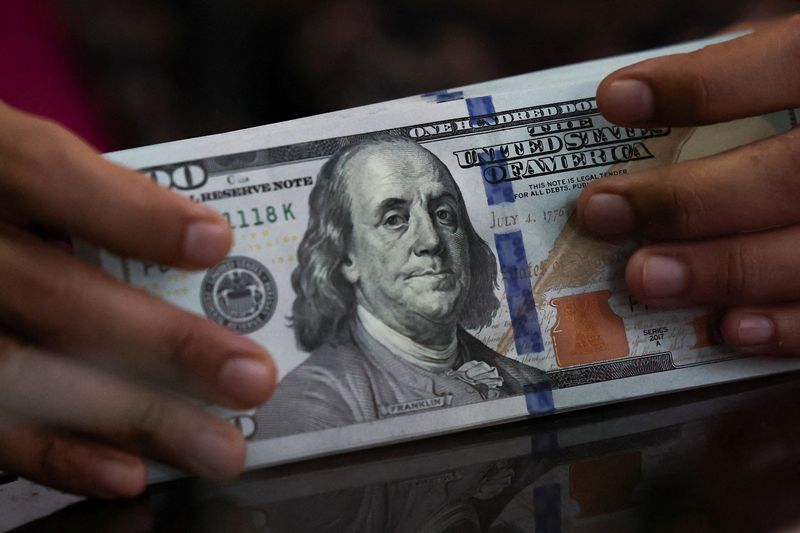
By Kevin Buckland
TOKYO (Reuters) -The dollar slumped on Friday as waning confidence in the U.S. economy prompted investors to ditch U.S. assets to the benefit of safe havens such as the Swiss franc, yen and euro, as well as gold.
The yellow metal recorded a new all-time peak, and the franc notched a fresh decade high.
Investors dumped Wall Street stocks overnight, as a powerful relief rally on Wednesday - when President Donald Trump abruptly paused higher tariff rates on dozens of trading partners - reversed course in a frenetic 24-hour period for markets. Longer-dated U.S. Treasuries are also selling off, putting 10-year yields on course for their biggest weekly jump since 2001.
Trump’s 90-day respite, which came despite his insistence for days that his policies would never change, didn’t include China. Instead, he ratcheted up duties on Chinese imports to an effective 145% rate, further escalating a high-stakes confrontation between the world’s two largest economies.
The Chinese yuan had tumbled to an all-time low in offshore trading on Tuesday, but erased all those losses a day later, and surged again on Thursday. It initially strengthened in the latest session as well, before trading slightly weaker.
"There has been a pronounced ’sell U.S.’ vibe flowing through broad markets and into the classic safe-haven assets, with the USD losing the safe-haven bid," said Chris Weston, head of research at Pepperstone.
"The moves (have) the feel of repatriation flows by foreign entities, with many re-focused on the idea that Trump’s reluctant pause on tariffs was due to increased system risk, and migrating capital away from Ground Zero."
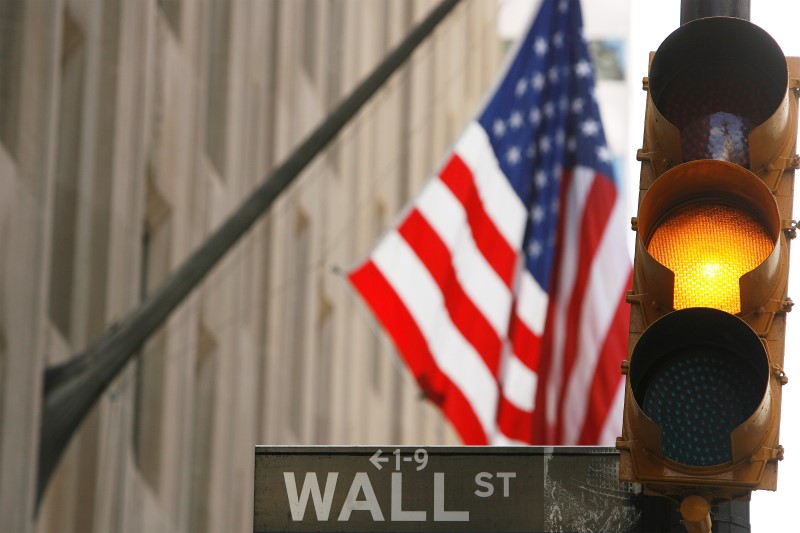
U.S. stock index futures fell on Thursday evening following a sharp drop on Wall Street as a rapidly escalating trade war with China offset relief over President Donald Trump postponing plans for global tariffs.
Futures turned negative after reversing early gains, as investors remained on edge over worsening trade relations between the U.S. and China, and the implications this would have on the global economy. The White House also clarified that China now faces 145% U.S. tariffs, which could invite more retaliation from Beijing.
S&P 500 Futures fell 0.7% to 5,265.0 points, while Nasdaq 100 Futures fell 0.9% to 18,304.50 points by 20:02 ET (00:02 GMT). Dow Jones Futures fell 0.7% to 39,520.0 points.
Markets largely looked past data showing a bigger-than-expected fall in consumer price index inflation in March, given that core CPI still remained sticky.
Wall St slides as US-China trade war ramps up
Futures fell after a negative session on Wall Street, as concerns over a U.S.-China trade war offset relief from Trump announcing a 90-day extension for his plans to impose reciprocal tariffs.
Trump hiked tariffs against China sharply this week, drawing ire and retaliation from Beijing, which struck back with 84% tariffs on U.S. goods. Chinese officials also vowed to “fight to the end” in what appeared to be a rapidly escalating trade war between the world’s biggest economies.
Trump also maintained a harsh rhetoric against China, pointing to few chances that a trade deal will be struck soon.
Investors fretted over the economic impact of tariffs on China, given that the U.S. still imports several key materials from the country, which are not easily replaceable. China is also a key market and manufacturing hub for several major U.S. firms, especially Wall Street heavyweight Apple (NASDAQ:AAPL), which slid 4.2% on Thursday.
This factored into steep losses on Wall Street, with the S&P 500 falling 3.5% to 5,268.05 points. The NASDAQ Composite slid 4.3% to 16,387.31 points, while the Dow Jones Industrial Average fell 2.5% to 16,387.31 points.
Still, all three indexes were headed for their first positive week in three, and were trading up between 3% and 5.2% so far this week. A bulk of these gains were clocked on Wednesday, after Trump postponed his plans for reciprocal tariffs.
Q1 earnings due amid heightened economic uncertainty
Investors were now bracing for the first-quarter earnings season, which begins on Friday with prints from several major banks. JPMorgan Chase & Co (NYSE:JPM), Wells Fargo & Company (NYSE:WFC), Morgan Stanley (NYSE:MS), Bank of New York Mellon (NYSE:BK), and private equity giant BlackRock Inc (NYSE:BLK) will report Q1 earnings on Friday.
Goldman Sachs Group Inc (NYSE:GS) will report earnings on Monday.
Earnings bring another layer of uncertainty to already volatile markets, with focus squarely on whether corporate earnings deteriorated amid heightened economic turmoil in the first quarter of Trump’s second term.
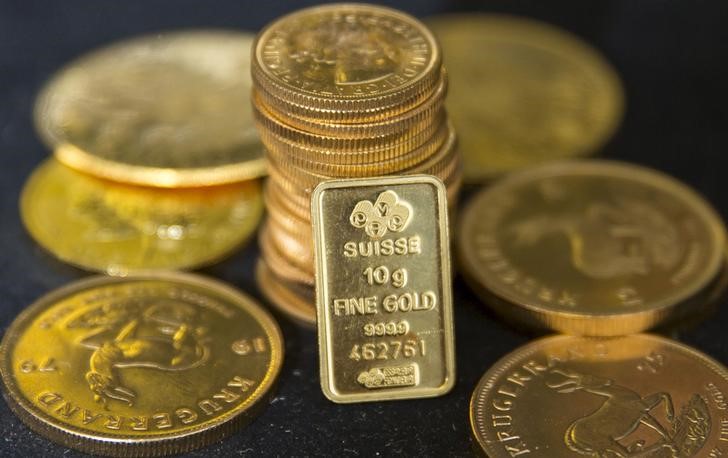
Gold prices hit a record high on Thursday, as safe-haven demand remained firm amid escalating trade tensions with China despite President Donald Trump’s 90-day pause on reciprocal tariffs for most countries.
As of 4:30 PM ET, Spot Gold jumped 2.83% to $3,170.27 per ounce. Gold Futures expiring in June jumped 3.54% to $3,188.56 an ounce.
The yellow metal reached a prior record high on April 3, after tariffs were announced, but hefty losses in other financial markets led to investors selling gold to cover losses elsewhere, leading to recent declines.
Gold nears record high as US-Sino tensions escalate
Gold’s renewed momentum was sparked on Wednesday as new tariffs imposed by the U.S. officially took effect.
While Trump quickly followed with a 90-day pause for most trading partners, he simultaneously raised tariffs on Chinese imports to 145%, stoking fears of deeper trade disruptions.
Meanwhile, China’s elevated tariffs of 84% on U.S. imports took effect on Thursday.
The mixed signals have left investors wary of further escalation between the world’s two largest economies. Persistent uncertainty around trade policy continues to drive demand for gold, seen as a hedge against geopolitical and economic instability.
The US Dollar Index edged 1.8% lower, making gold cheaper for overseas buyers.
Among other precious metals, Silver Futures jumped 2.3% to $31.11 an ounce, while Platinum Futures gained 2.14% to $939.70 an ounce.
Copper surges on tariff pause; uncertainty persists
Copper Futures jumped 4.4% on Thursday as investors cheered Trump’s 90-day pause, although caution persisted on higher China tariffs.

